The process of jet propulsion in an octopus is presented in simplified form in Figs. 1 - 2. The process is the same whether the animal is simply ventilating its ctenidia (gills) for gas exchange or whether it is jetting. There are two mantle openings, separated by the siphon. The openings are closed by flapper valves that pop into place during exhalation, thus forcing all the water out the siphon. Correct alignment of the two mantle-cavity openings (Fig. 3) in relation to the siphon is ensured by symmetrically placed cartilaginous locking devices, termed here flapper valves. Correct alignment ensures that the two flapper valves open and close without back-flow leakage during exhalation (Fig. 4). On entry into the mantle cavity the two flows irrigate the paired ctenidia , and then before exiting the now single flow picks up fecal discharge from the anus, urine from the nephridiopores, and ink from the ink sac. Massive contraction of mantle musculature creates a propulsive jet from the siphon, that can be oriented in any direction.

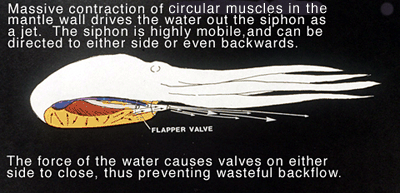
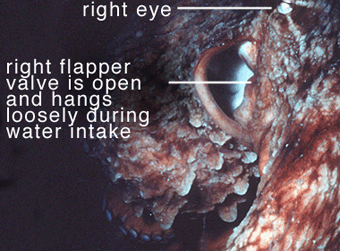
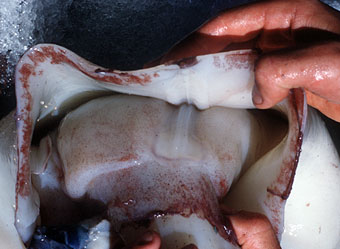
Research Study 1


Water flow through a squid functions both for gas exchange and jetting locomotion. Studies on the pelagic squid Doryteuthis opalescens (Fig. 1) at the University of British Columbia indicate a different pattern for each function. During escape jetting, for example, there are three phases: 1) filling of the mantle cavity powered largely by elastic recoil of the mantle wall from the previous jetting, with a small contribution from the radial muscles, 2) hyperinflation of the mantle cavity through contraction of radial muscles drawing more water in, and 3) expulsion of the water powered by contraction of circular muscles. Hyperinflation serves to fill the mantle cavity maximally, making the jet more powerful. In comparison, the more gentle pulsation of gas exchange is done in two ways, either by radial-muscle power or circular-muscle power, but both being antagonised by mantle tissue elasticity (Fig. 2). The study emphasises the important role played by storage of elastic energy in the connective tissue-fibers of the mantle wall in both locomotion and gas exchange (for accounts of temperature-compensation effects and prey-capture experience on escape jetting in squids Doryteuthis opalescens see Neumeister, 2000 and Preuss & Gilly, 2000).
Neumeister et al. 2000 J Exp Biol 203: 54
Preuss & Gilly 2000 J Exp Biol 203: 559
Research Study 2
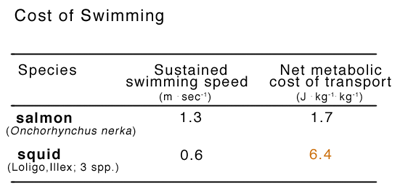

Squids locomote by a combination of finning and jetting, and open-water species can maintain a pace of 1 - 2km • h-1 for weeks at a time. During fast jetting the fins are rolled up to reduce drag. How does the jet-propulsion swimming of a squid compare with tail-wagging swimming of a fish? Acually, not well. A squid uses over three times as much energy to travel half as fast as a sockeye salmon of comparable size (Fig. 1). Fig. 2 shows the net cost of transport for various tail-wagging fishes, including sockeye salmon, in comparison with several species of planktonic crustaceans and three species of squids. The authors note the one advantage of squids over fishes in this regard is that the jet system automatically increases water flow over the ctenidia as swimming speed increases. Fishes expend increasing amounts of energy to ventilate their gills with increased velocity.
O'Dor 1982 Can J Fish Aquat Sci 39: 580
Research Study 3
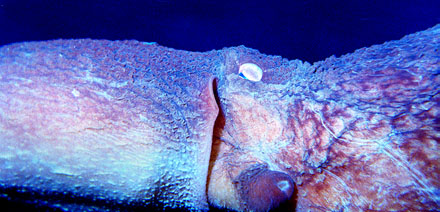
Jetting is used by octopuses (Fig. 1) not just for escape locomotion, but also for cleaning out potential homes, digging clams from sand, and chasing fishes away from prey remains.
Research Study 4
Research at the Monterey Bay Aquarium Research Institute at Moss Landing, California and in situ video recordings in Monterey Bay with the ROV Ventana show that squids Doryteuthis opalescens of 10 - 120mm mantle length swim at an average velocity of 0.2m • sec-1 with burst speeds up to 1.6m • sec-1. The authors provide a variety of morphometric measurements that allow handy identification of size of squids from the ROV video recordings. For example, a linear regression can predict dorsal mantle length (ML in mm) from a dimensionless ratio of mantle length over eye diameter taken from video records.
CLICK HERE to a selection of video clips of various swimming squids, octopuses, and cuttlefishes provided by the Monterey Bay Aquarium, California and hosted by YouTube
 Octopuses & relatives
Octopuses & relatives